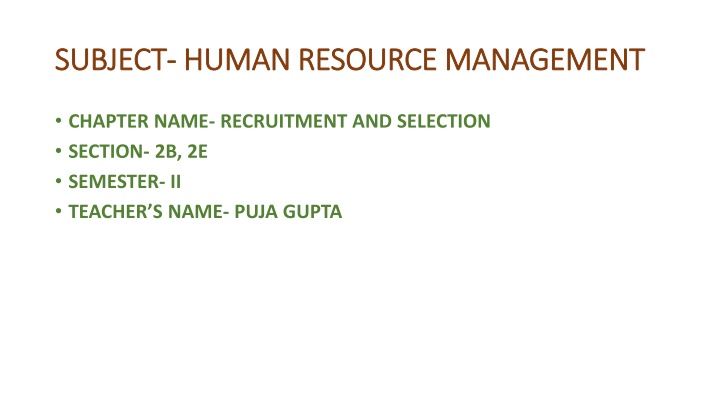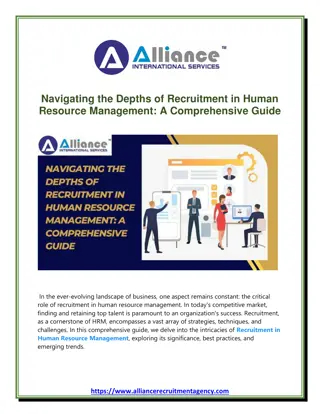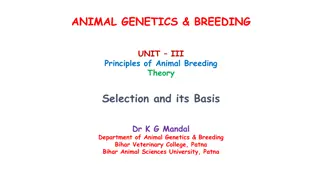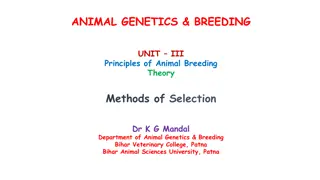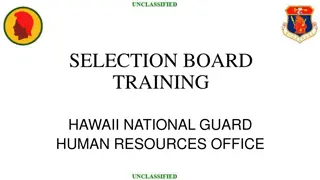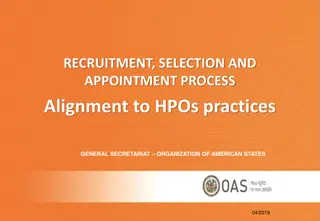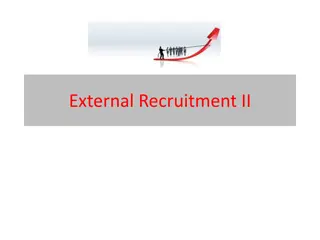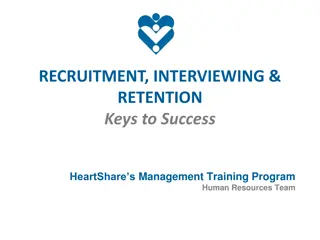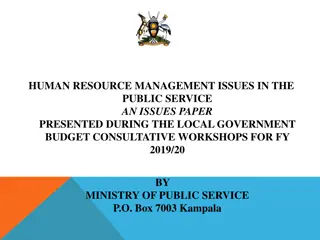Recruitment and Selection Process in Human Resource Management
Recruitment and selection are vital processes in human resource management. Recruitment involves attracting candidates for job positions within an organization through various sources, both internal and external. The steps in recruitment include planning, strategy development, searching, screening, and evaluation. Internal sources offer advantages like increased morale and easy selection, but they also have limitations such as limited scope and potential partiality. External sources bring new ideas and expertise but can be costly and time-consuming. Selection, on the other hand, involves choosing qualified individuals based on organizational requirements, with steps like initial interviews, tests, and reference checks.
Download Presentation

Please find below an Image/Link to download the presentation.
The content on the website is provided AS IS for your information and personal use only. It may not be sold, licensed, or shared on other websites without obtaining consent from the author.If you encounter any issues during the download, it is possible that the publisher has removed the file from their server.
You are allowed to download the files provided on this website for personal or commercial use, subject to the condition that they are used lawfully. All files are the property of their respective owners.
The content on the website is provided AS IS for your information and personal use only. It may not be sold, licensed, or shared on other websites without obtaining consent from the author.
E N D
Presentation Transcript
SUBJECT SUBJECT- - HUMAN RESOURCE MANAGEMENT HUMAN RESOURCE MANAGEMENT CHAPTER NAME- RECRUITMENT AND SELECTION SECTION- 2B, 2E SEMESTER- II TEACHER S NAME- PUJA GUPTA
RECRUITMENT RECRUITMENT DEFINITION:- Recruitment is the process of searching the places where required prospective candidates will be available for attracting and stimulating them to apply for jobs in the organization. STEPS IN RECRUITMENT PROCESS:- Recruitment planning Strategy development Searching Screening Evaluation and control.
SOURCES OF RECRUITMENT SOURCES OF RECRUITMENT INTERNAL SOURCES Promotions Transfers Internal advertisements Retired employees Present temporary or casual employees Disabled, retired, dependents of deceased and present employees Employee referrals. EXTERNAL SOURCES Private employment agencies Public advertisements Campus recruitment Professional organizations Recommendations Casual applicants Mergers and acquisitions E- recruitment.
INTERNAL SOURCES INTERNAL SOURCES MEANING:- Recruitment of employees from within the organization. ADVANTAGES:- Less risk of selection of personnel Increase in morale Use of past experience Easy selection and placement DISADVANTAGES:- Prevents entry of new candidates Limited scope Vacancy cannot filled immediately Expensive Possibility of partiality Negligence of ability.
EXTERNAL SOURCES EXTERNAL SOURCES MEANING:- Recruitment of employees from the outside the organization. ADVANTAGES:- Brings new ideas Wide scope Expertise from other organizations Less possibility of partiality and nepotism No needs to maintain confidential records Reflection of new outlook DISADVANTAGES:- Costly Time consuming Attitude of dissatisfaction Leaving the organizations.
SELECTION SELECTION MEANING:- selection is the process of choosing the duly qualified and skilled persons according to the organizational requirements of the jobs. STEPS IN SELECTION PROCESS:- Preliminary interviews Application blanks/ forms Written tests Personal or employment interviews Checking references Medical examination Selection decision Job offer Contract of employment.
